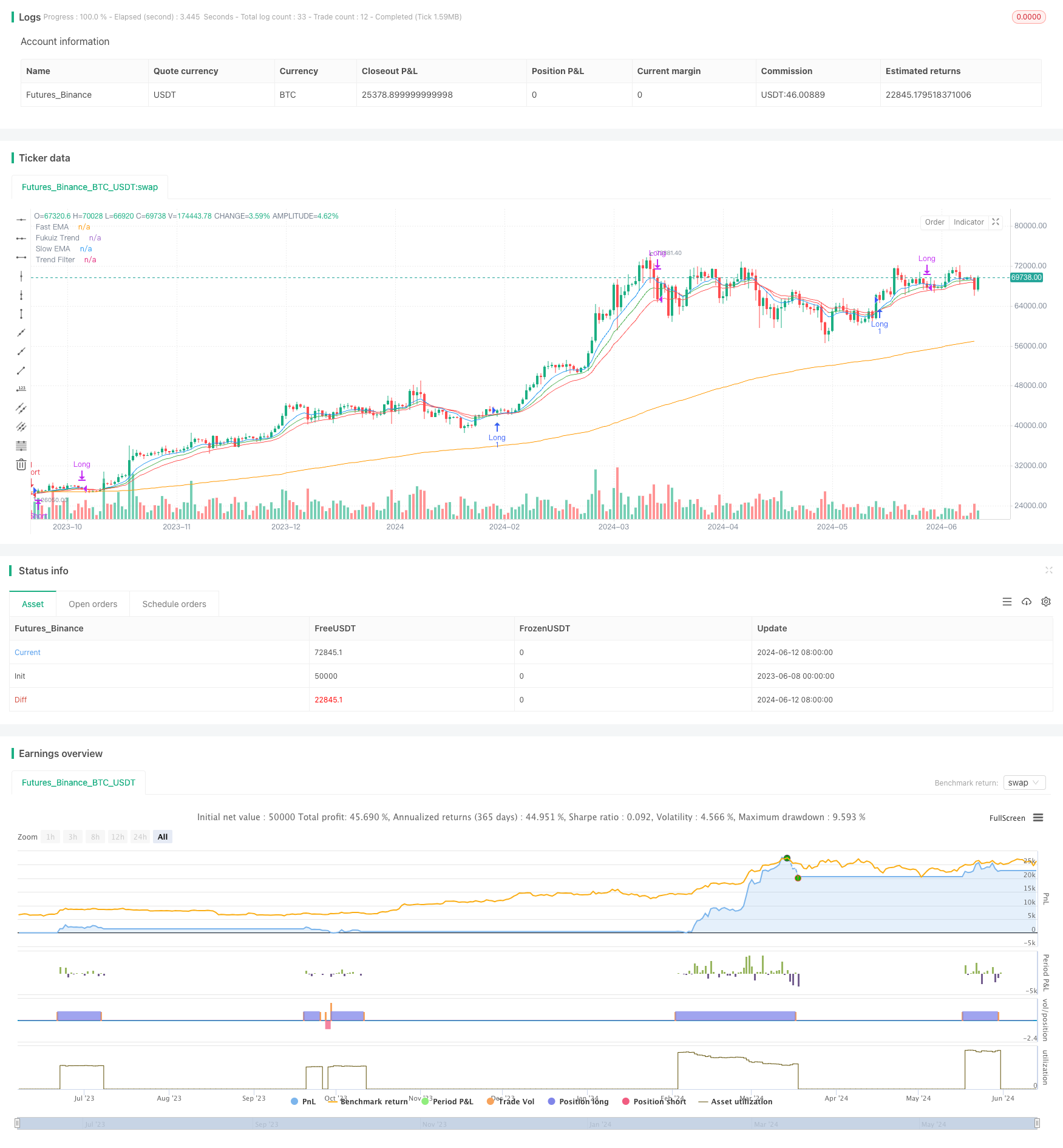
概述
该策略使用了三条不同周期的指数移动平均线(EMA)来判断市场趋势和买卖信号。快速EMA、慢速EMA和趋势过滤EMA的交叉情况,以及价格相对于趋势过滤EMA的位置,共同构成了该策略的核心逻辑。同时,该策略还引入了Fukuiz趋势指标作为辅助判断,在某些情况下会触发平仓操作。
策略原理
- 计算三条不同周期的EMA:快速EMA(默认9周期)、慢速EMA(默认21周期)和趋势过滤EMA(默认200周期)。
- 计算20周期的价格标准差,用于衡量市场波动率。
- 引入Fukuiz趋势指标(默认14周期EMA),并根据其与前一周期的大小关系确定颜色(上升为绿色,下降为红色)。
- 当快速EMA上穿慢速EMA,并且快速EMA高于慢速EMA,同时价格高于趋势过滤EMA时,产生买入信号。
- 当快速EMA下穿慢速EMA,并且快速EMA低于慢速EMA,同时价格低于趋势过滤EMA时,产生卖出信号。
- 当持有多头仓位时,如果Fukuiz趋势指标变为红色,平掉多头仓位。
- 当持有空头仓位时,如果Fukuiz趋势指标变为绿色,平掉空头仓位。
优势分析
- 通过多个周期的EMA组合,可以较好地捕捉市场趋势。
- Fukuiz趋势指标的引入,提供了额外的趋势判断依据,并在某些情况下起到止损的作用。
- 参数可调,适应性强,可以根据不同市场和周期进行优化。
风险分析
- EMA本质上是滞后指标,在市场快速转折时,可能出现信号延迟。
- 趋势过滤EMA周期较长,可能导致策略错过一些短期趋势。
- Fukuiz趋势指标的平仓逻辑可能导致策略过早止损,从而错失后续趋势。
优化方向
- 对各个EMA的周期参数进行优化,找到最适合当前市场的参数组合。
- 引入其他辅助指标,如RSI、MACD等,提供更多的入场和出场依据。
- 对Fukuiz趋势指标的止损逻辑进行优化,如加入一定的缓冲区,避免过早止损。
- 考虑加入仓位管理和风险控制模块,提高策略的稳定性和抗风险能力。
总结
该策略通过多个周期EMA的组合,以及Fukuiz趋势指标的辅助,构建了一个相对完整的趋势判断和交易框架。策略逻辑清晰,参数可调,适应性强。但同时也存在一些潜在风险,如信号滞后、趋势判断偏差等。未来可以从参数优化、指标组合、风险管理等方面对策略进行进一步完善。
策略源码
/*backtest
start: 2023-06-08 00:00:00
end: 2024-06-13 00:00:00
period: 1d
basePeriod: 1h
exchanges: [{"eid":"Futures_Binance","currency":"BTC_USDT"}]
*/
//@version=5
strategy("EvilRed Trading Indicator Trend Filter", overlay=true)
// Parameters Definition
fastLength = input(9, title="Fast EMA Length")
slowLength = input(21, title="Slow EMA Length")
trendFilterLength = input(200, title="Trend Filter EMA Length")
// Moving Averages Calculation
fastEMA = ta.ema(close, fastLength)
slowEMA = ta.ema(close, slowLength)
trendEMA = ta.ema(close, trendFilterLength)
// Volatility Calculation
volatility = ta.stdev(close, 20)
// Add Fukuiz Trend Indicator
fukuizTrend = ta.ema(close, 14)
fukuizColor = fukuizTrend > fukuizTrend[1] ? color.green : color.red
plot(fukuizTrend, color=fukuizColor, title="Fukuiz Trend")
// Plotting Moving Averages
plot(fastEMA, color=color.blue, title="Fast EMA")
plot(slowEMA, color=color.red, title="Slow EMA")
plot(trendEMA, color=color.orange, title="Trend Filter")
// Plotting Buy and Sell Signals
buySignal = ta.crossover(fastEMA, slowEMA) and fastEMA > slowEMA and close > trendEMA
sellSignal = ta.crossunder(fastEMA, slowEMA) and fastEMA < slowEMA and close < trendEMA
// Entry and Exit Conditions
if (strategy.position_size > 0 and fukuizColor == color.red)
strategy.close("Long", comment="Fukuiz Trend is Red")
if (strategy.position_size < 0 and fukuizColor == color.green)
strategy.close("Short", comment="Fukuiz Trend is Green")
if (buySignal)
strategy.entry("Long", strategy.long)
if (sellSignal)
strategy.entry("Short", strategy.short)
plotshape(buySignal, style=shape.triangleup, location=location.belowbar, color=color.green, size=size.small, title="Buy Signal")
plotshape(sellSignal, style=shape.triangledown, location=location.abovebar, color=color.red, size=size.small, title="Sell Signal")
相关推荐